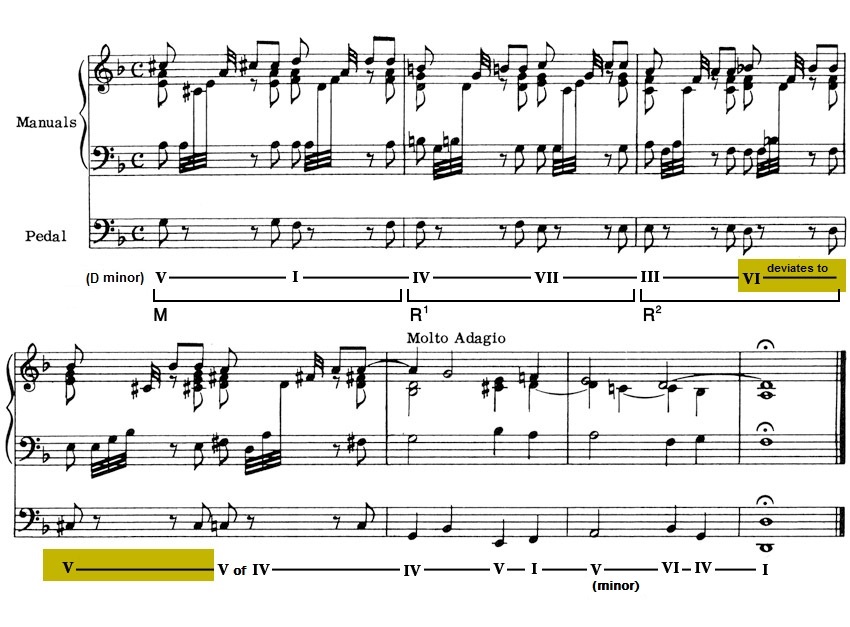6. THE MECHANISM OF DEVIATION
Finally,
the last element of this theory of constants in the non-modulating
harmonic discourse, the third mechanism of intervention in the basic
structure corresponds to a leap (sometimes backwards) in the harmonic discourse.

The four types of deviation:
1) Deviation via semantic alteration of a chord with a structure common to two distinct functions
Example 27 : F. Schubert : Piano Sonata, op. 120, no 3, D. 664, I (mm 107-112)

The
half-diminished seventh chord appearing on the fourth beat of measure
110 will be heard first as V of III m.m. (mixed mode) due to what
preceded (here a systematic progression through the circle of fifths
including substitutions with secondary dominants), before being
reinterpreted as II m.m. (mixed mode) in accordance with what follows
(a cadential formula).

2) Deviation via enharmonic alteration of a chord having a structure common to two functions
Example 28 : C.P.E. Bach : Solfeggietto (mm 26-31)

The
chord appearing on the first beat of measure 29 will be heard first as
V of N in the form of a dominant seventh structure (Ab - C - Eb - Gb)
due to what preceded (as in example 27),
before being reinterpreted as V of V (Ab - C - Eb - F#) in the form of
a dominant minor ninth structure, without the root and with a lowered
fifth (commonly called a German sixth*), in accordance with what follows (as in example 27).

3) Deviation via chromatic alteration of a chord which slides towards another (most often towards V) usually
through a chromatic movement (or several, depending on the case)
Example 29 : L.V. Beethoven : String Quartet, op. 18, no 5, IV (mm 36-43)


See also example 225, where the analysis of measures 12-13 shows that VII which follows IV deviates chromatically towards V, and then example 434, where we find the function II at the end of a sequence sliding towards V through two chromatic movements.
4) Deviation from any function in the cycle towards V which translates into a sort of excitement in the discourse:
Example 30 : J.S. Bach : Toccata in G major, BWV 916, Adagio (mm 1-4)

Example 31 : J.S. Bach : Toccata and Fugue in D minor for Organ, BWV 565, Vivace (end)

Example 32: L.V. Beethoven : Symphony no 7, op. 92, I, Poco sostenuto (mm 1-10)

Example 33 : J. Brahms : Symphony no 1, op. 68, IV, Allegro non troppo, ma con brio (mm 119-122)


To
conclude this presentation concerning the three modes of intervention
in the fundamental structure, it is necessary to mention that the mechanisms of
substitution (firstly) and of interpolation (secondly) are by far the
most common, a fact which gives rise to a preferential rule:
In
a case where more than one mechanism of intervention may be used to
explain a rupture in the systematic progression through the descending
circle of fifths, we prioritise according to the following order:
1 - substitution
2 - interpolation
3 - deviation - with the four types also in order: 1, 2, 3, 4
Thus,
for example, the H.S.U. I - IV - V - I employs a substitution (the
function IV substituting for the function II) rather than a type 4
deviation of any function in the cycle towards the function V.
